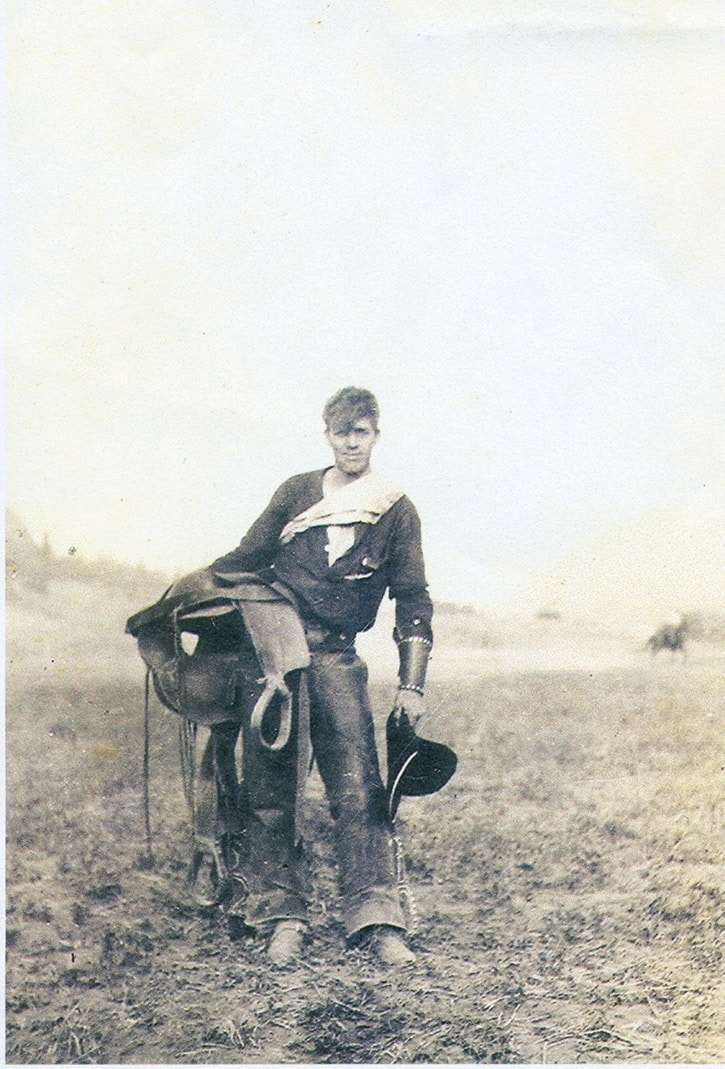This year marks the 90th running of the Williams Lake Stampede, a show which tests the mettle of the best cowboys and stock that can be found.
In all that time, however, there has only been one person who has lost his life in the arena, and that was Lloyd “Cyclone” Smith.
Lloyd was born in 1895 in Davenport, Washington, and grew up in that area. He came to the Cariboo just after the Second World War, arriving in Williams Lake a few month after his parents, who were the owners and operators of the new Maple Leaf Hotel.
Lloyd was already a well-known rodeo rider in the U.S. and it didn’t take him long to find work cowboying and breaking horses on local ranches.
He was a dashing, good looking fellow who had a reputation for being fearless (some would say foolhardy) on horseback. He rode in many saddle and bareback competitions in both B.C. and Washington State, usually placing in the money.
There seem to be two versions about how he got the nickname “Cyclone.”
One is that he was so named by Jo Fleiger, one of the founders of the town’s first stampede, who was reputed to have said: “Every time that Smith rode, it was a wild ride and it looked like a regular cyclone happening.”
The other is that the name came from the way he rode the Mountain Race. Most riders chose a zig-zag path down the hill, and kept their horses at a careful pace.
Not Smith.
He just race straight down at a speed just a little short of suicidal, ending up at the bottom in a cloud of dust, and often in the lead. Folks remarked that he looked like a cyclone coming down the hill.
Whichever the origin, his nickname stuck, and Cyclone Smith became the Cariboo’s own King of the Cowboys.
With his good looks and fearless reputation, Smith caught the ye of many of the local ladies.It is said he would ride in the annual Stampede parade on his prancing black horse and impress the crowd by twirling his lariat, then roping the prettiest of the girls lining the street.
One such capture was a beautiful red head named Mary Alice Gibson. In time, a romance blossomed and they were married. They had one son, Lloyd William, whom the townspeople, not surprisingly, nicknamed “Tornado.”
Unfortunately, Cyclone Smith was too restless to settle down, and he continued in his wandering ways. He and Mary drifted apart and, eventually, the marriage ended.
Enter the Countess Beatrice Calonna di Montecchio, a very rich English woman who had at one time been married to an Italian nobleman.
By the time she arrived in the Cariboo in 1927, that relationship was over, but she continued to use the name and title. She met Cyclone through mutual friends at Lac La Lache, and over the ensuing months they became quite close.
They went into a business venture together, a hunting and fishing tourist lodge at Timothy lake, and it was there that the Countess set up residence.
Cyclone could not stay away from the rodeo circuit, and he continued his activities as a daredevil rider, but he made frequent visits back to Timothy Lake.
By all accounts, quite a romance developed between them.
In 1932, Cyclone was the arena manager and was also doing pick-up duties at the Stampede when the accident occurred.
A bronc had thrown its rider and was heading for a hole in the fence.
Cyclone rushed off on his mount to head it off.
The two horses collided, Cyclone’s foot caught a stirrup and he fell underneath his horse as it went down. The saddle horn crushed his chest and broke several ribs, some of which punctured his lung.
Cyclone was transported, unconscious, to the hospital.
Even though the doctor used all his medical skills, 36 hours later, Smith died without ever regaining consciousness.
The Countess was by his side. It was June 29, 1932, and Cyclone was just 37 years old.
His body was placed behind the hospital in an old shed, which served as the local morgue.
The Countess was appalled that this was the only place for a body to be kept until the funeral.
She decided that she would have a chapel and mortuary built in memory of her friend and lover.
So it was that the structure was built. It stood for years right next to the old hospital, about where the present grassy circle is in the middle of our City Hall parking lot.
It had a little altar, stained glass windows, a natural wood interior and a few small pews.
On one wall hung a plaque inscribed with the words: “A courageous, honest man, a good scout, an ideal companion.”
Next to the plaque was a framed photograph of Cyclone holding a coyote by the tail (local legend has it that when the photo was taken, he was holding a live coyote).
The Countess left the Cariboo soon after the chapel was dedicated, and only returned for two or three brief visits.
When the current hospital was built in 1962, the foundations of the little chapel were crumbling, and it had to be demolished.
The heavy front doors, the pews and the stained glass windows ended up in Roe Lake, where that community was planning to build a small chapel of its own.
I don’t think it was ever done.
At our Museum of the Cariboo-Chilcotin, you can still find the silver candlesticks, a kneeling cushion, a Bible and a framed poem, all of which came from the Countess’s chapel.
Cyclone’s saddle is also there on display, all reminders of this legendary cowboy and his aristocratic lady.
Much of the information in this article comes from stories written by Irene Stangoe and Liz Twan.
